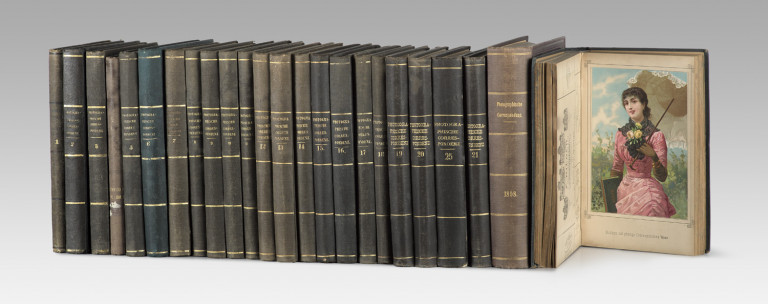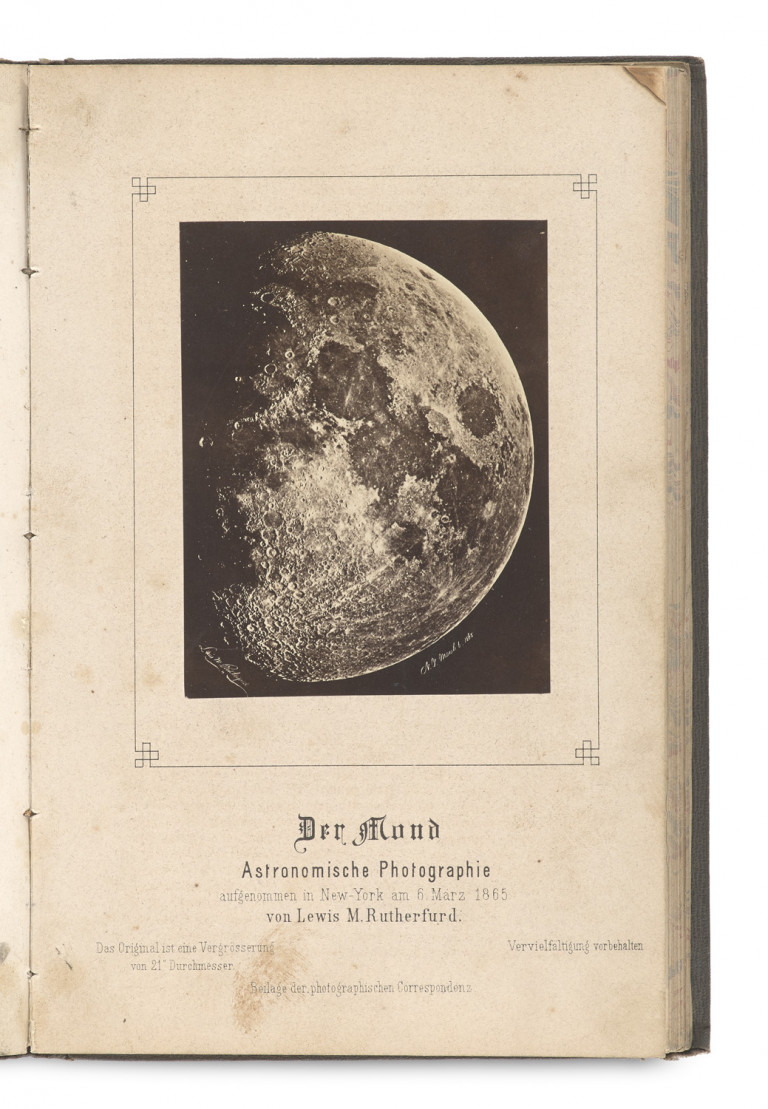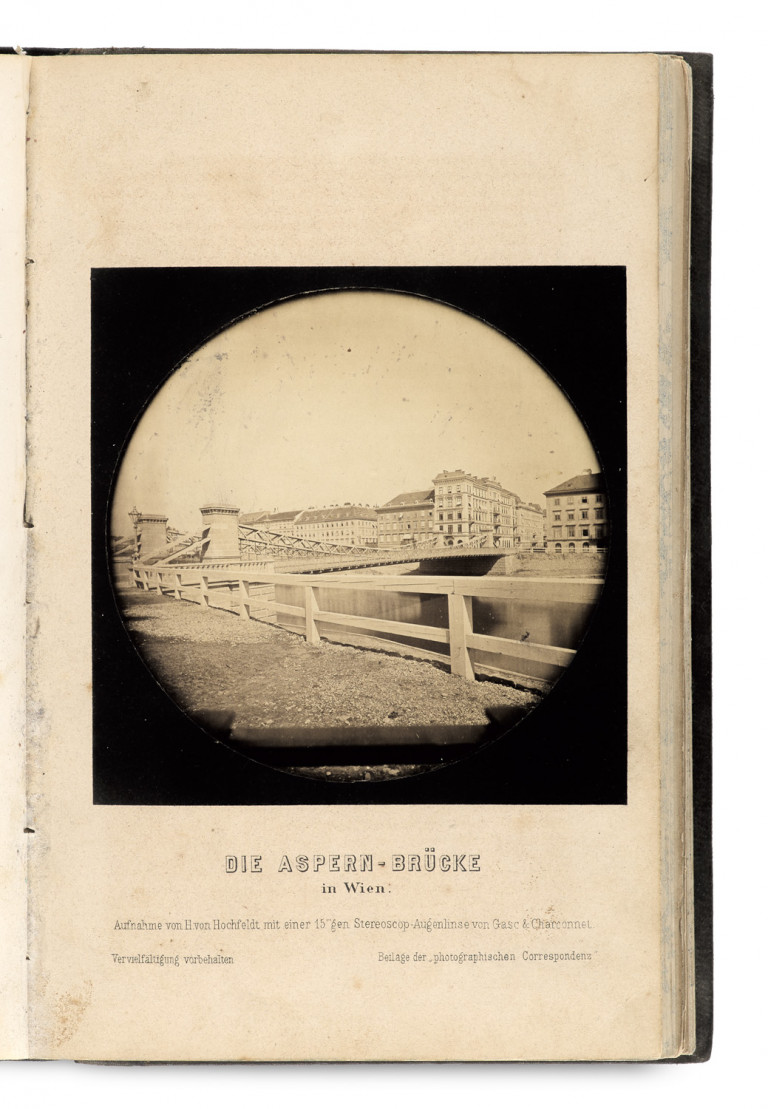Online Catalogue with all Lots / Auction 157
Rare Books, Prints, Historical Photography
Friday, 24 October 2025 at 11:00 am Lose 1- 1105
Saturday, 25 October 2025 at 11:00 am Lose 1106-2003 - After sale
Lot 1737 Photographische Gesellschaft in Wien. Photographische …
Photographische Correspondenz. Jahrgänge 1 (1864) bis 22 (1885), 25 (1888) und 35 (1898). Nrn. 1-303, 328-339 und 448-459 in 24 Bänden. Mit 39 (von 45) auf Karton montierten Original-Fotografien, wovon 35 aus den Jahren 1864-74, u.a. von J. Albert, L. Angerer, C. Aubel, L. Rutherfurd and W. Woodbury, sowie 285 (von 300), teils farbigen Bildtafeln mit ebenfalls großteils auf Karton montierten Edeldrucken nach Fotos, sowie zahlreichen Textillustrationen. Wien u. Leipzig, Gerold u. Selbstvlg. d. Photogr. Ges., 1865-98. Ca. 6000 Seiten. 8°. Ln. (Jg. 4 Hln.) d. Zt. mit goldgepr. RTit. und großteils marmor. Schnitt.
Photographie - Photographen – Außergewöhnliche Sammlung bestehend aus den Jahrgängen 1-22 (1864-1885) der »Photographischen Correspondenz«, einer bedeutenden Zeitschrift der frühen Photographie. - Umfangreicher Korpus, der bis auf die wenigen fehlenden Beilagen die Blütezeit abbildet, dazu die Jge. 25 (1888) und 35 (1898). - Größere Konvolute von Jahrgängen beinhaltend auch die Frühzeit der 1860er-Jahre für uns auf Auktionen nur ein Mal nachweisbar (1988). - Nur für Mitglieder der Wiener Photographischen Gesellschaft hergestellt (142 im Jahr 1864, ca. 500 um 1900), darüber hinaus wurden für verwandte Institutionen bzw. Inserenten einige wenige Tausch- und Belegexemplare gefertigt. Da die aufwändigen "artistischen Beilagen" teuer waren, wird die Auflage wohl nur wenige hundert Exemplare betragen haben (vgl. Starl, S. 87). - Seit den frühen 1850er-Jahren war die Entwicklung der Fotografie in Fachperiodika umfänglich dokumentiert und befördert worden. In Frankreich (ab 1851), England und Österreich (ab 1854), den USA (1858) und Deutschland (ab 1860) waren Zeitschriften erschienen, doch keine wurde so früh so maßgeblich wie die Wiener »Photographische Correspondenz« für den deutschsprachigen Raum. - Die Texte der Zeitschrift verhandeln fototechnische und fotochemische Neuerungen, geben Anleitungen für Berufsfotografen, behandeln Drucktechniken, sowie wissenschaftliche, wirtschaftliche und ästhetische Aspekte der Fotografie. "Fixed to ideals of craftmenship, the magazine focused on composition, lightning, posing, and the different genres of photography. Fine Art was discussed in its practical aspects, from the discussion of printing processes to questions of the copyright for photographs." (Sachsse) Beiträger waren die Herausgeber, allesamt führende Exponenten der »Photographischen Gesellschaft in Wien«, heimische Fotografen wie Ludwig Angerer oder J. Löwy, oder Wissenschafter wie Ernst Mach, aber auch ausländische Fachleute, wie Friedrich Bruckmann, Louis-Alphones Davanne, Emilie Vogelsang, oder die Genannten. - Die reichhaltigen Bildbeigaben, mehrheitlich Porträts, Genrebilder und Stilleben, aber auch einige Landschaften und Stadtszenerien (u.a. 2 Aufnahmen von Hermann Hochfeldt der Wiener Aspern-Brücke, 1865), bestanden zunächst v.a. aus Originalabzügen (deren 41 wurden in die Jge. 1-10 aufgenommen), die auf rückseitig oft mit Anzeigen bedruckten, starken Kartons aufgeklebt wurden. Sie stammten hauptsächlich aus Wiener Ateliers, z.B. von Ludwig Angerer, Fritz Luckhardt und Josef Székely. In der Folge wurden gedruckte Wiedergaben von Fotos dominant, wobei bereits etablierte Vervielfältigungsverfahren mit ökonomischen Nutzen für Ateliers und den Handel vorrangig Berücksichtigung fanden, z.B. Aubeldruck, Heliogravüre, Lichtdruck (u.a. die Albertotypie), Lithographie, Kupferätzung, Pigmentdruck, Reliefdruck, Silberdruck, Similigravüre, Woodburydruck und Zinkographie. Das Gros der Edeldrucke lieferten, neben den Wiener Ateliers, Werkstätten mit internationalem Renommee, wie Joseph Albert, Carl Aubel, Karl Klietsch, Charles Reutlinger, Lewis Rutherfurd und Walter Woodbury. - Jg. 4 (aus der Bibl. d. DÖAV) mit Stempel auf Titelbl.) ist nur als Textbd. vorhanden, die 12 Beil., wovon 4 Or.-Fotos, fehlen. Bindung aufgrund der Verwendung starker Montagekartons stellenweise gelockert, Vordergelenk von Jg. 2 gebrochen, Einbände teils etwas berieben und an den Kanten teils bestoßen, einige Tafeln im Zuge des Bindens beschnitten und mit leichtem Textverlust der Bildlegenden, einige Jahrgänge teils etwas stockfleckig, ansonsten kompakter Satz dieser fotohistorisch ausnehmend bedeutenden Zeitschrift. - Tim Starl: "Diese Zeitschrift ist für historische Studien sehr aufschlußreich." Die Photographische Korrespondenz von 1864-1922. In: Michael Ponstingl, Hg.: Die Explosion der Bilderwelt. Die Photographische Gesellschaft in Wien 1861-1945. Publikation anlässlich der gleichnamigen Ausstellung in der Albertina, Wien (17. Juni bis 2. Oktober 2011). Wien: Brandstätter 2011, Ss. 80-93, Otto Hochreiter/Tim Starl: Der zweite Durchblick. Bildbeigaben der "Photographischen Correspondenz" (1864-1971). Ausstellungskatalog Museum moderner Kunst, Wien, Juli/August 1984. Wien: 1984 (mit zahlr. Abb. v. Bildbeigaben, nennt im Vorwort vorliegenden Satz als Leihgabe), Rolf Sachsse: Photographische Correspondenz. In: John Hannavy, Ed.: Encyclopedia of Nineteenth Century Photography. New York: 2007, p. 1095.
Photography – With 39 (of 45) original photographs mounted on cardboard, 35 of which from the years 1864-74. - Exceptional set of vol. 1-22 (1864-1885) of the 'Photographische Correspondenz', an important journal of early photography. Extensive corpus which, apart from the few missing supplements, depicts the heyday, plus vols. 25 (1888) and 35 (1898). - Larger sets of complete vols. including the early 1860s can only be traced once at auction (1988). - Only produced for members of the Vienna Photographic Society (142 in 1864, approx. 500 around 1900), in addition a few exchange and specimen copies were produced for related institutions or advertisers. As the elaborate 'artistic supplements' were expensive, the print run was probably only a few hundred copies (cf. Starl, p. 87). - Since the early 1850s, the development of photography had been extensively documented and promoted in specialised periodicals. Journals had been published in France (from 1851), England and Austria (from 1854), the USA (1858) and Germany (from 1860), but none became as authoritative as the Viennese 'Photographische Correspondenz' for the German-speaking world so early on. - The magazine's texts deal with technical and photochemical innovations, provide instructions for professional photographers, cover printing techniques, as well as scientific, economic and aesthetic aspects of photography. 'Fixed to ideals of craftmenship, the magazine focused on composition, lightning, posing, and the different genres of photography. Fine Art was discussed in its practical aspects, from the discussion of printing processes to questions of the copyright for photographs.' (Sachsse) The contributors were the editors, all leading exponents of the 'Photographische Gesellschaft in Wien', local photographers such as Ludwig Angerer or J. Löwy, or scientists such as Ernst Mach, but also foreign experts such as Friedrich Bruckmann, Louis-Alphones Davanne, Emilie Vogelsang, or the aforementioned. - The rich pictorial supplements, mostly portraits, genre pictures and still lifes, but also some landscapes and city scenes (including 2 photographs by Hermann Hochfeldt of the Aspern Bridge in Vienna, 1865), initially consisted mainly of original prints (41 of which were included in vols. 1-10), which were glued onto thick cardboard often printed with adverts on the reverse. They came mainly from Viennese studios, e.g. Ludwig Angerer, Fritz Luckhardt and Josef Székely. Subsequently, printed reproductions of photographs became dominant, whereby already established reproduction processes with economic benefits for studios and the trade were prioritised, e.g. Aubel printing, heliogravure, collotype (including the Alberotype), lithography, copper etching, pigment printing, relief printing, silver printing, similigravure, Woodbury printing and zincography. In addition to the Viennese studios, the majority of fine prints were produced by workshops of international renown, such as Joseph Albert, Carl Aubel, Karl Klietsch, Charles Reutlinger, Lewis Rutherfurd and Walter Woodbury. - Vol. 4 (from the DÖAV library) with stamp on title page) is only available as a text volume, the 12 supplements, of which 4 original photos, are missing. Binding loose in places due to the use of strong mounting boards, front hinge of vol. 2 broken, covers somewhat rubbed in places and bumped at edges, some plates trimmed in the course of binding and with slight loss of text in the captions, some volumes somewhat foxed in places, otherwise a compact set of this exceptionally important photographic-historical journal. - For further ref. see above.
Post Auction Price: 3500 €
Premium and taxation
This piece is subject to differential taxation. There is a 28.95% buyer's premium on the hammer price. The value added tax is included but not displayable according to §25a UstG.
Shipping
A pickup of this work is possible in our premises at Potsdamer Str. 16, 14163 Berlin by appointment. If you wish a shipment of the work, please contact us for a consultation and shipping calculation.
Terms and Conditions
You can view our terms and conditions here
Droit de Suite
On the sales proceeds of all original works of fine art and photography, whose authors have not yet died 70 years before the end of the sale, an additional 2% (subject to change) of the hammer prices from 400€ will be charged pro rata for the VG Bild-Kunst, which represents the copyrights of visual artists according to § 26 UrhG.
Submit a bid
I would like to participate in your auction by accepting the General Terms and Conditions of Jeschke van Vliet Auctions Berlin GmbH.


